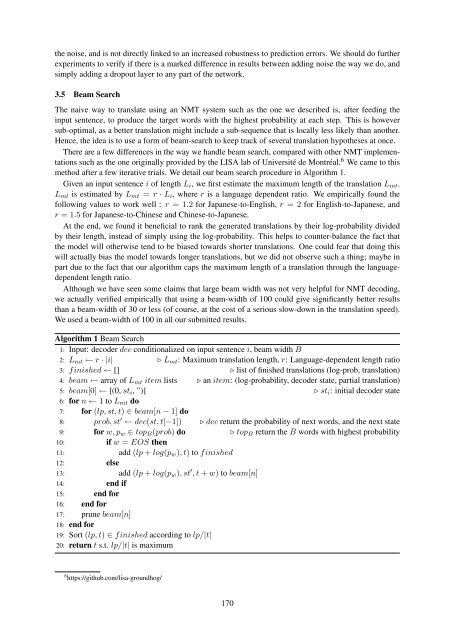December 11-16 2016 Osaka Japan
W16-46
W16-46
You also want an ePaper? Increase the reach of your titles
YUMPU automatically turns print PDFs into web optimized ePapers that Google loves.
the noise, and is not directly linked to an increased robustness to prediction errors. We should do further<br />
experiments to verify if there is a marked difference in results between adding noise the way we do, and<br />
simply adding a dropout layer to any part of the network.<br />
3.5 Beam Search<br />
The naive way to translate using an NMT system such as the one we described is, after feeding the<br />
input sentence, to produce the target words with the highest probability at each step. This is however<br />
sub-optimal, as a better translation might include a sub-sequence that is locally less likely than another.<br />
Hence, the idea is to use a form of beam-search to keep track of several translation hypotheses at once.<br />
There are a few differences in the way we handle beam search, compared with other NMT implementations<br />
such as the one originally provided by the LISA lab of Université de Montréal. 6 We came to this<br />
method after a few iterative trials. We detail our beam search procedure in Algorithm 1.<br />
Given an input sentence i of length L i , we first estimate the maximum length of the translation L mt .<br />
L mt is estimated by L mt = r · L i , where r is a language dependent ratio. We empirically found the<br />
following values to work well : r = 1.2 for <strong>Japan</strong>ese-to-English, r = 2 for English-to-<strong>Japan</strong>ese, and<br />
r = 1.5 for <strong>Japan</strong>ese-to-Chinese and Chinese-to-<strong>Japan</strong>ese.<br />
At the end, we found it beneficial to rank the generated translations by their log-probability divided<br />
by their length, instead of simply using the log-probability. This helps to counter-balance the fact that<br />
the model will otherwise tend to be biased towards shorter translations. One could fear that doing this<br />
will actually bias the model towards longer translations, but we did not observe such a thing; maybe in<br />
part due to the fact that our algorithm caps the maximum length of a translation through the languagedependent<br />
length ratio.<br />
Although we have seen some claims that large beam width was not very helpful for NMT decoding,<br />
we actually verified empirically that using a beam-width of 100 could give significantly better results<br />
than a beam-width of 30 or less (of course, at the cost of a serious slow-down in the translation speed).<br />
We used a beam-width of 100 in all our submitted results.<br />
Algorithm 1 Beam Search<br />
1: Input: decoder dec conditionalized on input sentence i, beam width B<br />
2: L mt ← r · |i| ▷ L mt : Maximum translation length, r: Language-dependent length ratio<br />
3: finished ← [] ▷ list of finished translations (log-prob, translation)<br />
4: beam ← array of L mt item lists ▷ an item: (log-probability, decoder state, partial translation)<br />
5: beam[0] ← [(0, st i , ”)] ▷ st i : initial decoder state<br />
6: for n ← 1 to L mt do<br />
7: for (lp, st, t) ∈ beam[n − 1] do<br />
8: prob, st ′ ← dec(st, t[−1]) ▷ dec return the probability of next words, and the next state<br />
9: for w, p w ∈ top B (prob) do ▷ top B return the B words with highest probability<br />
10: if w = EOS then<br />
<strong>11</strong>: add (lp + log(p w ), t) to finished<br />
12: else<br />
13: add (lp + log(p w ), st ′ , t + w) to beam[n]<br />
14: end if<br />
15: end for<br />
<strong>16</strong>: end for<br />
17: prune beam[n]<br />
18: end for<br />
19: Sort (lp, t) ∈ finished according to lp/|t|<br />
20: return t s.t. lp/|t| is maximum<br />
6 https://github.com/lisa-groundhog/<br />
170



